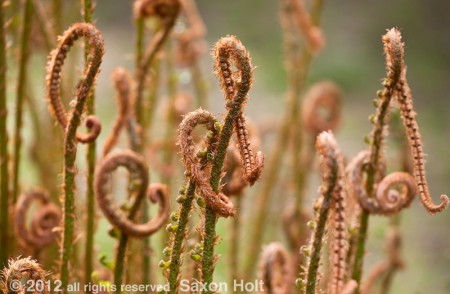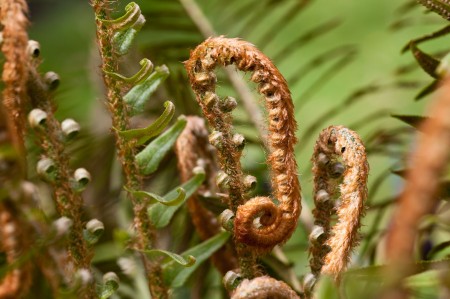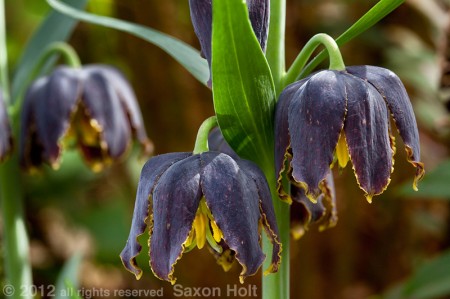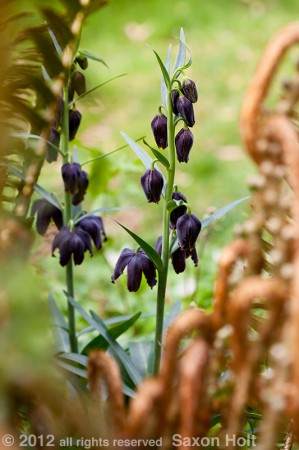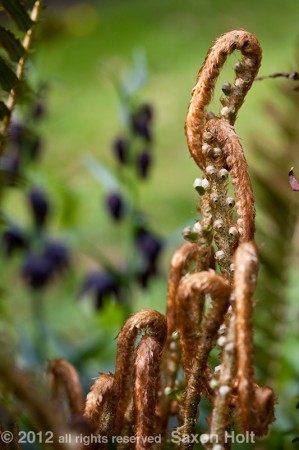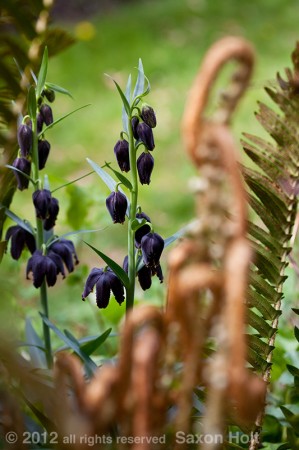It’s wildflower season ! Grab you camera (and tripod), some sturdy shoes, sunblock , a bottle of water, and go study what is unfolding in nature. The miracles become all the more fantastic by examining the wonder in the details.
A macro lens is essential for studying nature close up. It will allow close focusing so you can fill your frame with the flower, leaf, or bug; and with a dedicated macro lens, as opposed to a point and shoot with macro capability, you can get some very special photos.
For these photos of the Western Sword Fern (Polystichum munitum) I used my 100mm macro lens. I love this lens. Being a short telephoto, it not only allows you to get a close photo from a foot away instead of inches away, you can pick focus points that will allow blurring of the foreground or background.
Or, in the case of the next photo, you can isolate a detail within a plant. I will say this once – use a tripod whenever you can. Not only is it really hard to hold the camera steady when using a telephoto macro and, your composition will be much stronger as you decide where to focus and wait for the wind to keep thing still. Do these fronds look like elephant trunks, or what ?!
When I arrived at Tilden Park above Berkeley, and the native plant garden which is the East Bay Regional Parks Botanic Garden, the first wildflower I found was the Mission Bells Chocolate Lily (Fritillaria lanceolata) growing next to the Sword fern, with Heuchas in the foreground.
A snap shot is a boring view. Actually it may be boring for a lesson on focal points, but for a lesson in how to combine native plants of different sizes in a garden, this is a pretty informative photograph. But anyway, do note the relative closeness of the two plants.
To create an interesting shot of the Lily I got down close and a bit under the flower (using the tripod. OK, I said this twice) so I could see the anthers within, and composed a shot that reveals the two plants. Using the 100mm macro with a fairly wide aperture (f:5.6) I could let the background focus go soft.
Now to get some really cool shots of the lily and fern together, I go on the other side of the fern. (Did you remember to note their relative position in that photo above?) Now shooting through the fern I can isolate the entire flower stalk of the fritillary. For the purpose of this lesson, the first frame is with a lot of depth of field, f:22 on my lens.
But having that lawn area in fairly sharp focus, because of the good depth of field, the lily does not really stand out. Here is where a shallow depth of field (f:5.6) will really help accent the focus point of the photograph.
I didn’t change the focus point itself, only the aperture. Now let’s see what happens if I do change the focus point, next, to see the fern frond unfolding. The tripod is in exactly the same position, though I did swivel the camera just a bit to help my composition. The fern as focus point stands out because the macro lens isolated the details and the aperture kept the rest of the photo in soft focus.
So when we talk about the focus point of a macro photograph there are two camera controls we need to understand. Choose a focus point within the frame that creates a strong composition, putting your most important details in sharp focus. Then choose an aperture that controls how much depth of field you want surrounding the focus point.
I really like it when you can look through a soft area to a sharp point and have the background blur. If done well, the soft foreground will help you frame the photo and draw attention to the main subject, giving the sense of a more intimate view. A classic way to get inside the garden.
Using telephoto lenses and controlling the depth of field for landscape views, rather than macros, is one more lesson in garden photography that I will be teaching in a class at the East Bay Regional Parks Botanic Garden the week-end of April 28-29. And eventually, all will be part of my e-book.
White bark poplars behind red twig dogwood. I do love the native plants of California. You should love the natives of your State. Go see them now. Bring your tripod . . .

